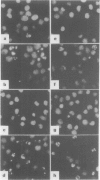Abstract
The characteristics of cell death were investigated after exposure of CCRF-CEM.f2 cells to five drugs over a broad concentration range; these were the glucocorticoid dexamethasone (DXM), the mitotic inhibitor vincristine (VIN) and three antimetabolites, methotrexate (MTX), 5'-fluoro-2'-deoxyuridine (FUdR) and 5'-fluorouracil (5-FU). Drug-treated cells were monitored for cell death mechanisms at different times by examining the pattern of DNA degradation, cell morphology and flow cytometric profile, together with effects on cell growth over 72 h. At growth-inhibitory drug concentrations, the first changes were cell cycle perturbations detectable after 4-6 h of drug exposure. The appearance of features characteristic of apoptotic cell death was noted after all drug treatments in the CCRF-CEM.f2 cell line, but the pattern and kinetics varied considerably. VIN induced apoptotic changes by 12 h, while DXM treatment caused apoptosis only after 48 h. Both MTX and FUdR induced morphological changes characteristic of apoptosis at least 24 h before internucleosomal DNA cleavage, which was detectable only after 48 h. In contrast, 5-FU did not cause internucleosomal DNA cleavage by 48 h at any concentration, despite the presence of morphologically apoptotic cells 24 h earlier. These data suggest that disruption of the cell cycle caused by drug treatment may be the common trigger initiating the drug-specific apoptotic sequence of dying cells.
Full text
PDF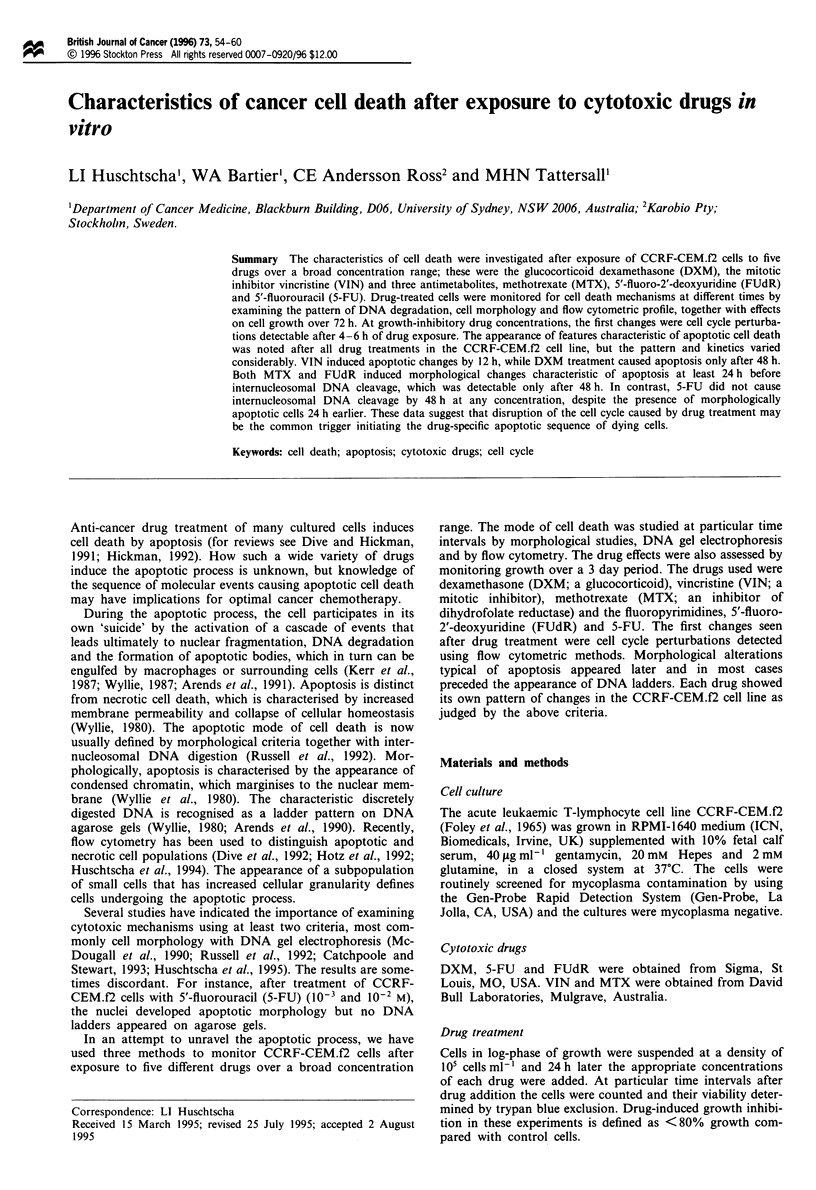
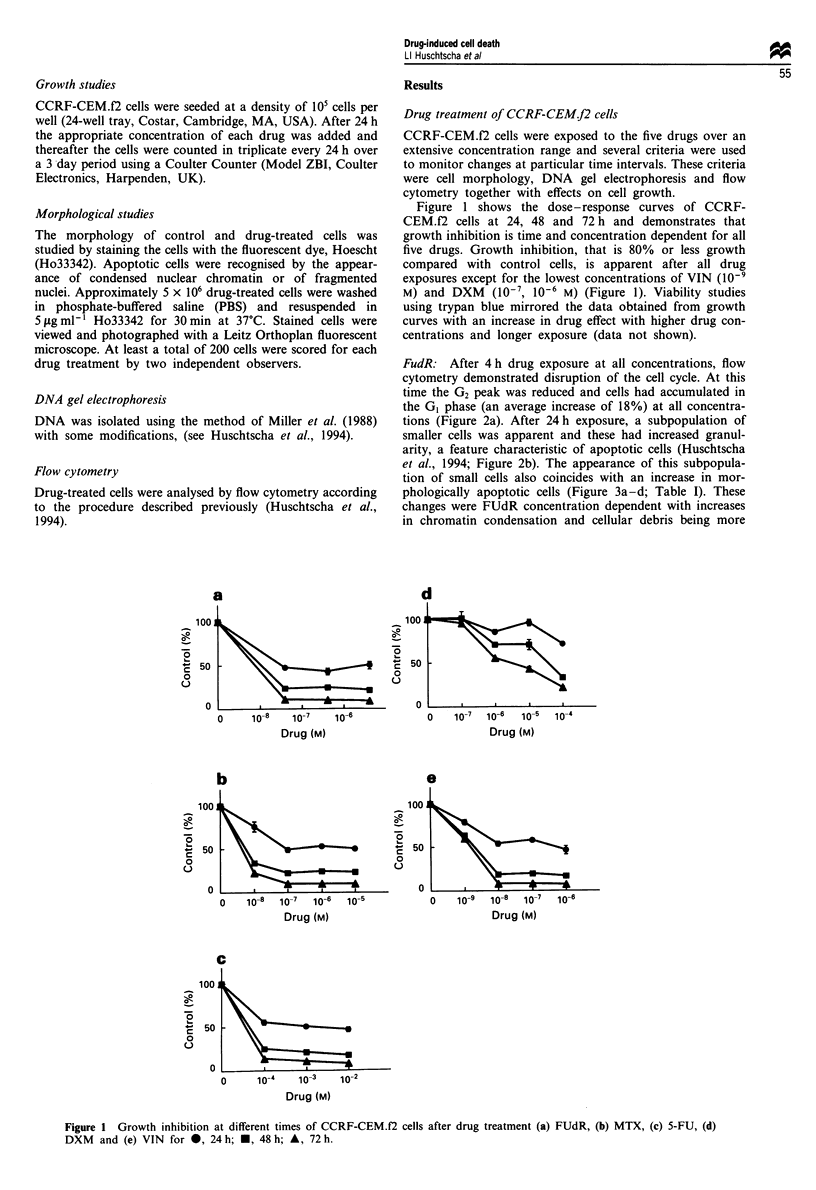

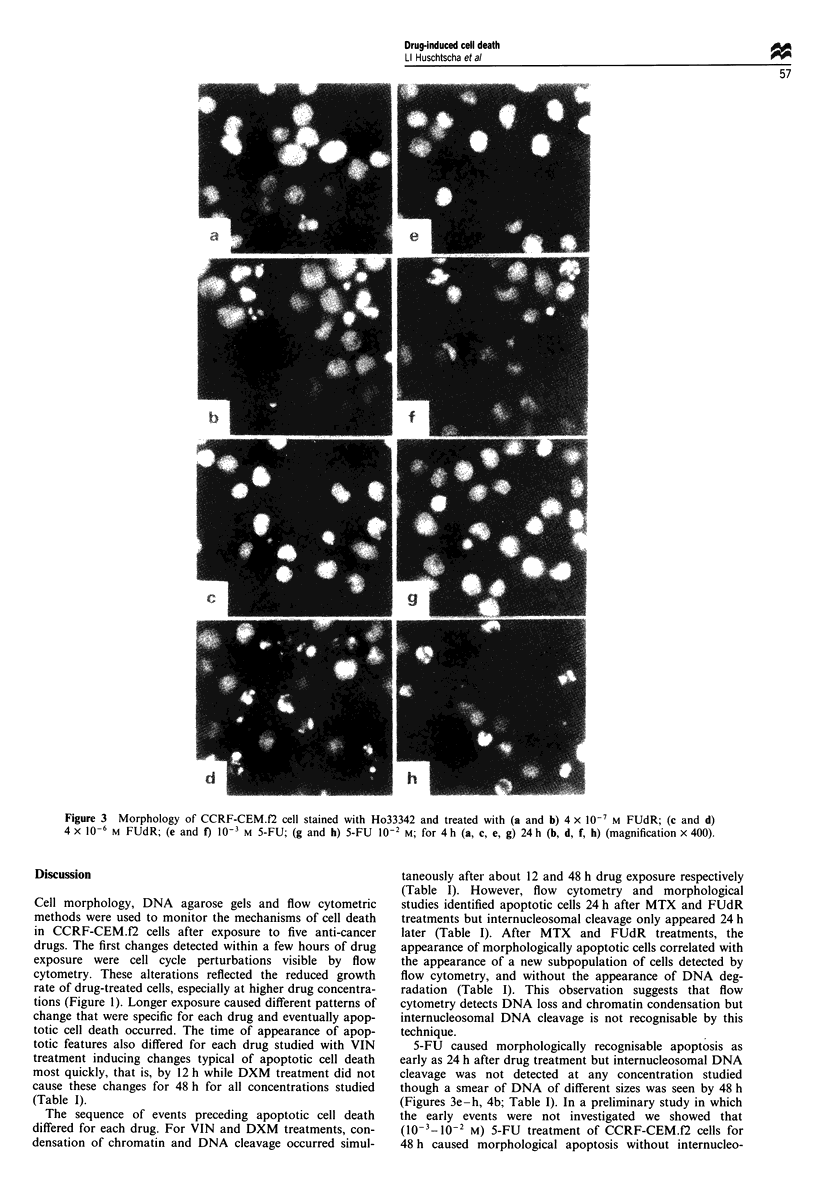
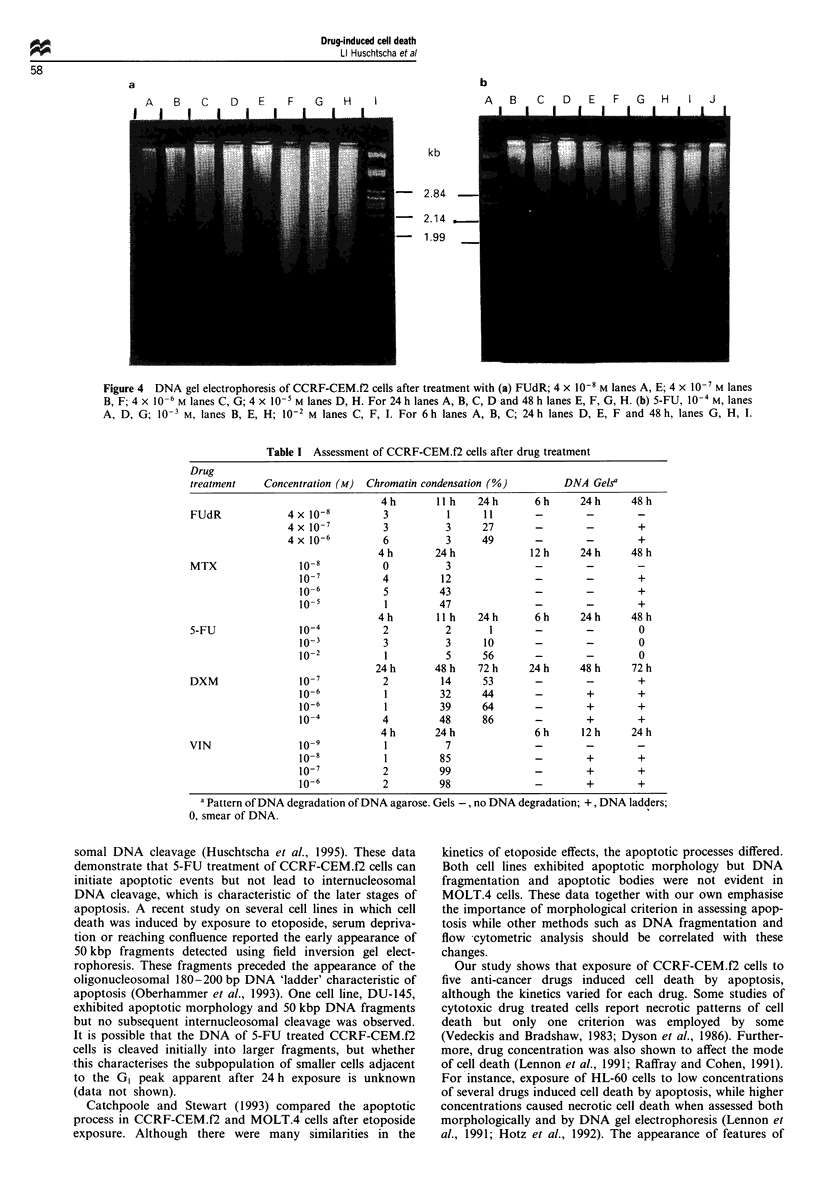
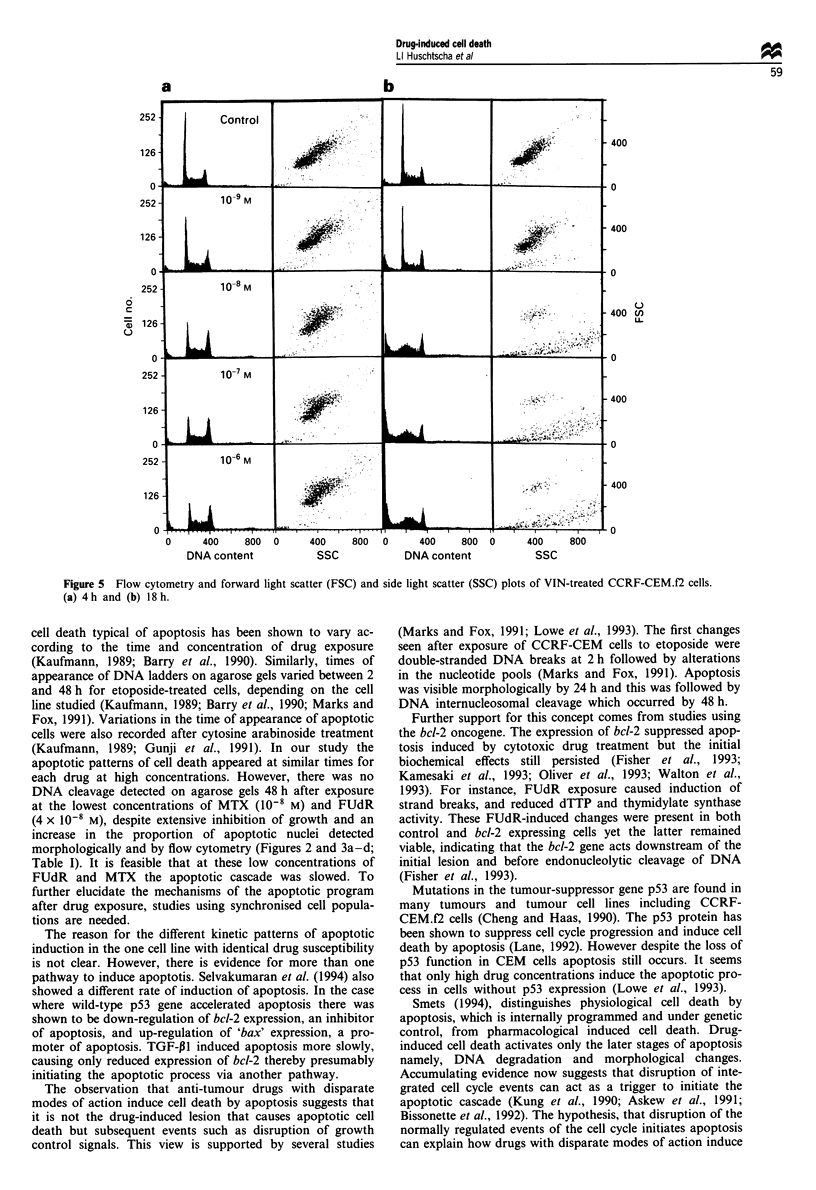
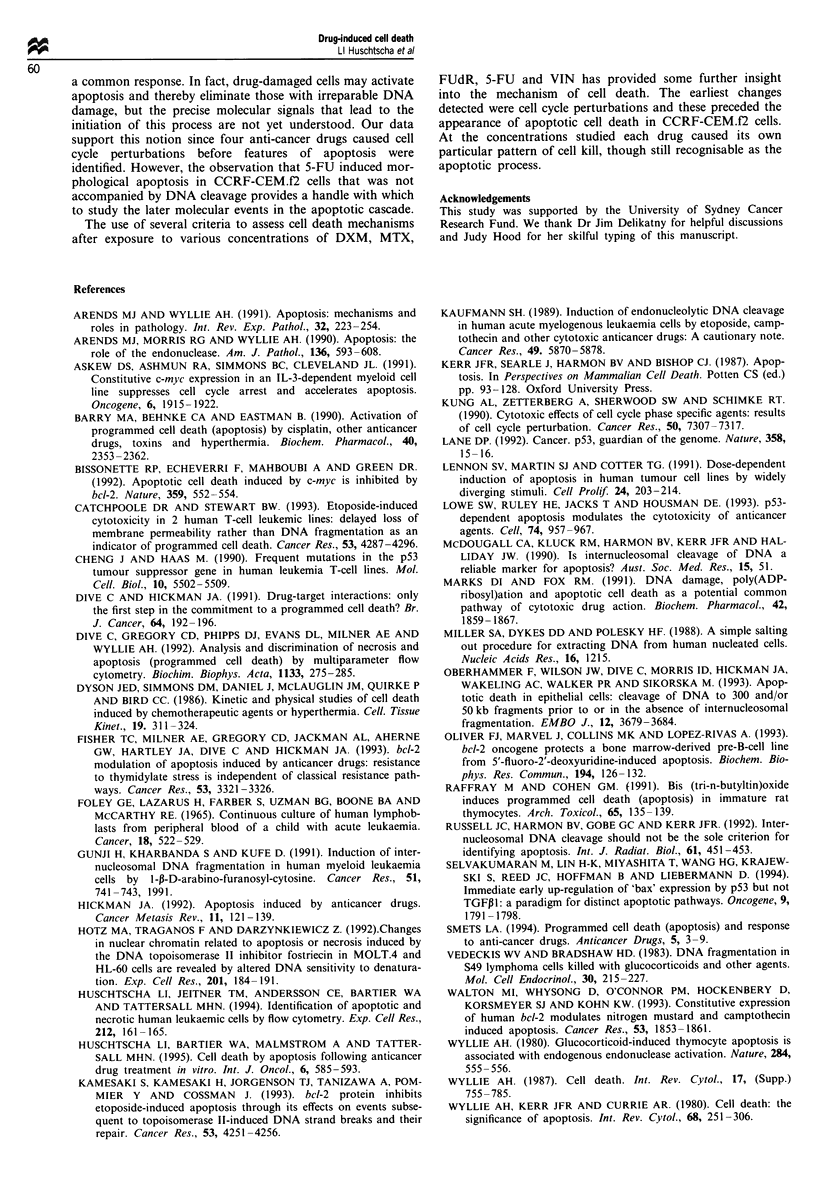
Images in this article
Selected References
These references are in PubMed. This may not be the complete list of references from this article.
- Arends M. J., Morris R. G., Wyllie A. H. Apoptosis. The role of the endonuclease. Am J Pathol. 1990 Mar;136(3):593–608. [PMC free article] [PubMed] [Google Scholar]
- Arends M. J., Wyllie A. H. Apoptosis: mechanisms and roles in pathology. Int Rev Exp Pathol. 1991;32:223–254. doi: 10.1016/b978-0-12-364932-4.50010-1. [DOI] [PubMed] [Google Scholar]
- Askew D. S., Ashmun R. A., Simmons B. C., Cleveland J. L. Constitutive c-myc expression in an IL-3-dependent myeloid cell line suppresses cell cycle arrest and accelerates apoptosis. Oncogene. 1991 Oct;6(10):1915–1922. [PubMed] [Google Scholar]
- Barry M. A., Behnke C. A., Eastman A. Activation of programmed cell death (apoptosis) by cisplatin, other anticancer drugs, toxins and hyperthermia. Biochem Pharmacol. 1990 Nov 15;40(10):2353–2362. doi: 10.1016/0006-2952(90)90733-2. [DOI] [PubMed] [Google Scholar]
- Bissonnette R. P., Echeverri F., Mahboubi A., Green D. R. Apoptotic cell death induced by c-myc is inhibited by bcl-2. Nature. 1992 Oct 8;359(6395):552–554. doi: 10.1038/359552a0. [DOI] [PubMed] [Google Scholar]
- Catchpoole D. R., Stewart B. W. Etoposide-induced cytotoxicity in two human T-cell leukemic lines: delayed loss of membrane permeability rather than DNA fragmentation as an indicator of programmed cell death. Cancer Res. 1993 Sep 15;53(18):4287–4296. [PubMed] [Google Scholar]
- Cheng J., Haas M. Frequent mutations in the p53 tumor suppressor gene in human leukemia T-cell lines. Mol Cell Biol. 1990 Oct;10(10):5502–5509. doi: 10.1128/mcb.10.10.5502. [DOI] [PMC free article] [PubMed] [Google Scholar]
- Collins R. J., Harmon B. V., Gobé G. C., Kerr J. F. Internucleosomal DNA cleavage should not be the sole criterion for identifying apoptosis. Int J Radiat Biol. 1992 Apr;61(4):451–453. doi: 10.1080/09553009214551201. [DOI] [PubMed] [Google Scholar]
- Dive C., Gregory C. D., Phipps D. J., Evans D. L., Milner A. E., Wyllie A. H. Analysis and discrimination of necrosis and apoptosis (programmed cell death) by multiparameter flow cytometry. Biochim Biophys Acta. 1992 Feb 3;1133(3):275–285. doi: 10.1016/0167-4889(92)90048-g. [DOI] [PubMed] [Google Scholar]
- Dive C., Hickman J. A. Drug-target interactions: only the first step in the commitment to a programmed cell death? Br J Cancer. 1991 Jul;64(1):192–196. doi: 10.1038/bjc.1991.269. [DOI] [PMC free article] [PubMed] [Google Scholar]
- Dyson J. E., Simmons D. M., Daniel J., McLaughlin J. M., Quirke P., Bird C. C. Kinetic and physical studies of cell death induced by chemotherapeutic agents or hyperthermia. Cell Tissue Kinet. 1986 May;19(3):311–324. doi: 10.1111/j.1365-2184.1986.tb00683.x. [DOI] [PubMed] [Google Scholar]
- FOLEY G. E., LAZARUS H., FARBER S., UZMAN B. G., BOONE B. A., MCCARTHY R. E. CONTINUOUS CULTURE OF HUMAN LYMPHOBLASTS FROM PERIPHERAL BLOOD OF A CHILD WITH ACUTE LEUKEMIA. Cancer. 1965 Apr;18:522–529. doi: 10.1002/1097-0142(196504)18:4<522::aid-cncr2820180418>3.0.co;2-j. [DOI] [PubMed] [Google Scholar]
- Fisher T. C., Milner A. E., Gregory C. D., Jackman A. L., Aherne G. W., Hartley J. A., Dive C., Hickman J. A. bcl-2 modulation of apoptosis induced by anticancer drugs: resistance to thymidylate stress is independent of classical resistance pathways. Cancer Res. 1993 Jul 15;53(14):3321–3326. [PubMed] [Google Scholar]
- Gunji H., Kharbanda S., Kufe D. Induction of internucleosomal DNA fragmentation in human myeloid leukemia cells by 1-beta-D-arabinofuranosylcytosine. Cancer Res. 1991 Jan 15;51(2):741–743. [PubMed] [Google Scholar]
- Hickman J. A. Apoptosis induced by anticancer drugs. Cancer Metastasis Rev. 1992 Sep;11(2):121–139. doi: 10.1007/BF00048059. [DOI] [PubMed] [Google Scholar]
- Hotz M. A., Traganos F., Darzynkiewicz Z. Changes in nuclear chromatin related to apoptosis or necrosis induced by the DNA topoisomerase II inhibitor fostriecin in MOLT-4 and HL-60 cells are revealed by altered DNA sensitivity to denaturation. Exp Cell Res. 1992 Jul;201(1):184–191. doi: 10.1016/0014-4827(92)90362-c. [DOI] [PubMed] [Google Scholar]
- Huschtscha L. I., Jeitner T. M., Andersson C. E., Bartier W. A., Tattersall M. H. Identification of apoptotic and necrotic human leukemic cells by flow cytometry. Exp Cell Res. 1994 May;212(1):161–165. doi: 10.1006/excr.1994.1131. [DOI] [PubMed] [Google Scholar]
- Kamesaki S., Kamesaki H., Jorgensen T. J., Tanizawa A., Pommier Y., Cossman J. bcl-2 protein inhibits etoposide-induced apoptosis through its effects on events subsequent to topoisomerase II-induced DNA strand breaks and their repair. Cancer Res. 1993 Sep 15;53(18):4251–4256. [PubMed] [Google Scholar]
- Kaufmann S. H. Induction of endonucleolytic DNA cleavage in human acute myelogenous leukemia cells by etoposide, camptothecin, and other cytotoxic anticancer drugs: a cautionary note. Cancer Res. 1989 Nov 1;49(21):5870–5878. [PubMed] [Google Scholar]
- Kung A. L., Zetterberg A., Sherwood S. W., Schimke R. T. Cytotoxic effects of cell cycle phase specific agents: result of cell cycle perturbation. Cancer Res. 1990 Nov 15;50(22):7307–7317. [PubMed] [Google Scholar]
- Lane D. P. Cancer. p53, guardian of the genome. Nature. 1992 Jul 2;358(6381):15–16. doi: 10.1038/358015a0. [DOI] [PubMed] [Google Scholar]
- Lennon S. V., Martin S. J., Cotter T. G. Dose-dependent induction of apoptosis in human tumour cell lines by widely diverging stimuli. Cell Prolif. 1991 Mar;24(2):203–214. doi: 10.1111/j.1365-2184.1991.tb01150.x. [DOI] [PubMed] [Google Scholar]
- Lowe S. W., Ruley H. E., Jacks T., Housman D. E. p53-dependent apoptosis modulates the cytotoxicity of anticancer agents. Cell. 1993 Sep 24;74(6):957–967. doi: 10.1016/0092-8674(93)90719-7. [DOI] [PubMed] [Google Scholar]
- Marks D. I., Fox R. M. DNA damage, poly (ADP-ribosyl)ation and apoptotic cell death as a potential common pathway of cytotoxic drug action. Biochem Pharmacol. 1991 Oct 24;42(10):1859–1867. doi: 10.1016/0006-2952(91)90582-p. [DOI] [PubMed] [Google Scholar]
- Miller S. A., Dykes D. D., Polesky H. F. A simple salting out procedure for extracting DNA from human nucleated cells. Nucleic Acids Res. 1988 Feb 11;16(3):1215–1215. doi: 10.1093/nar/16.3.1215. [DOI] [PMC free article] [PubMed] [Google Scholar]
- Oberhammer F., Wilson J. W., Dive C., Morris I. D., Hickman J. A., Wakeling A. E., Walker P. R., Sikorska M. Apoptotic death in epithelial cells: cleavage of DNA to 300 and/or 50 kb fragments prior to or in the absence of internucleosomal fragmentation. EMBO J. 1993 Sep;12(9):3679–3684. doi: 10.1002/j.1460-2075.1993.tb06042.x. [DOI] [PMC free article] [PubMed] [Google Scholar]
- Oliver F. J., Marvel J., Collins M. K., López-Rivas A. Bcl-2 oncogene protects a bone marrow-derived pre-B-cell line from 5'-fluor,2'-deoxyuridine-induced apoptosis. Biochem Biophys Res Commun. 1993 Jul 15;194(1):126–132. doi: 10.1006/bbrc.1993.1794. [DOI] [PubMed] [Google Scholar]
- Raffray M., Cohen G. M. Bis(tri-n-butyltin)oxide induces programmed cell death (apoptosis) in immature rat thymocytes. Arch Toxicol. 1991;65(2):135–139. doi: 10.1007/BF02034940. [DOI] [PubMed] [Google Scholar]
- Selvakumaran M., Lin H. K., Miyashita T., Wang H. G., Krajewski S., Reed J. C., Hoffman B., Liebermann D. Immediate early up-regulation of bax expression by p53 but not TGF beta 1: a paradigm for distinct apoptotic pathways. Oncogene. 1994 Jun;9(6):1791–1798. [PubMed] [Google Scholar]
- Vedeckis W. V., Bradshaw H. D., Jr DNA fragmentation in S49 lymphoma cells killed with glucocorticoids and other agents. Mol Cell Endocrinol. 1983 May;30(2):215–227. doi: 10.1016/0303-7207(83)90049-7. [DOI] [PubMed] [Google Scholar]
- Walton M. I., Whysong D., O'Connor P. M., Hockenbery D., Korsmeyer S. J., Kohn K. W. Constitutive expression of human Bcl-2 modulates nitrogen mustard and camptothecin induced apoptosis. Cancer Res. 1993 Apr 15;53(8):1853–1861. [PubMed] [Google Scholar]
- Wyllie A. H. Glucocorticoid-induced thymocyte apoptosis is associated with endogenous endonuclease activation. Nature. 1980 Apr 10;284(5756):555–556. doi: 10.1038/284555a0. [DOI] [PubMed] [Google Scholar]
- Wyllie A. H., Kerr J. F., Currie A. R. Cell death: the significance of apoptosis. Int Rev Cytol. 1980;68:251–306. doi: 10.1016/s0074-7696(08)62312-8. [DOI] [PubMed] [Google Scholar]



